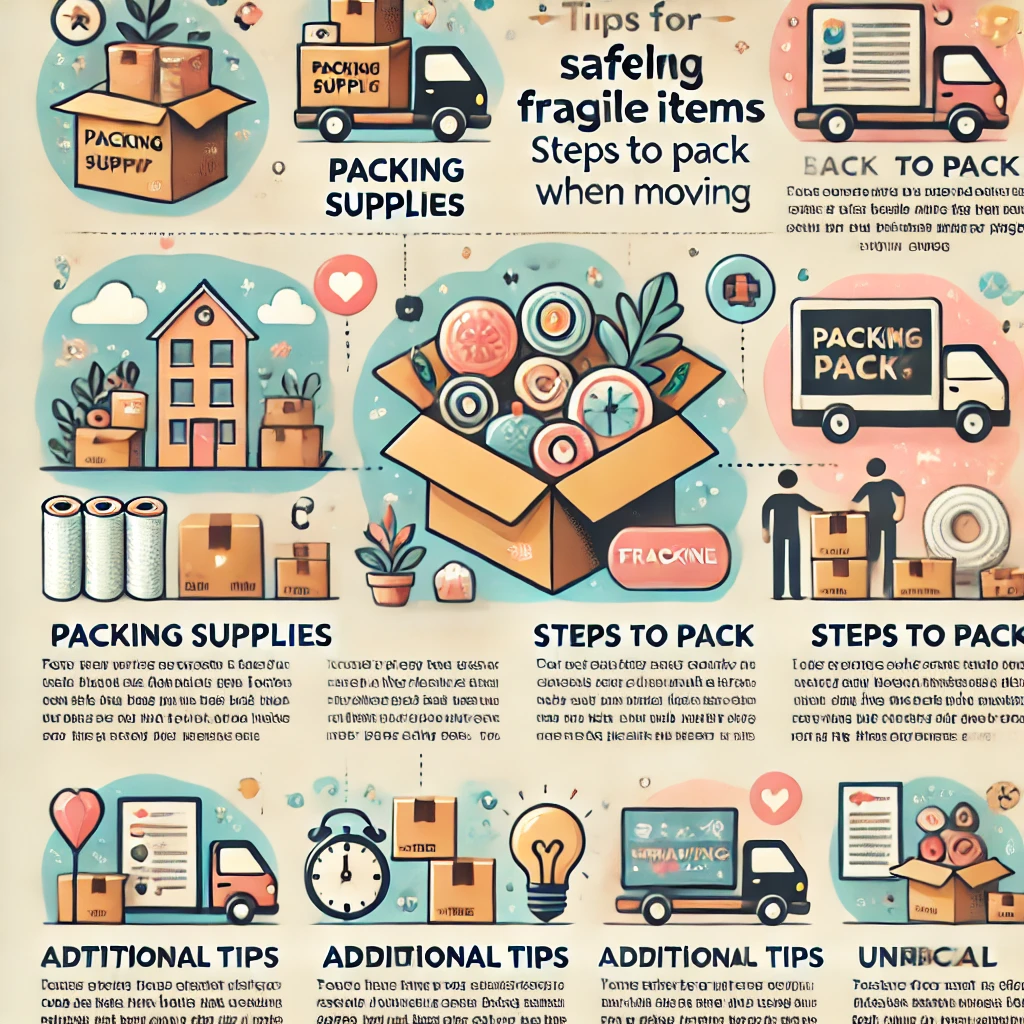Moving to a new home can be both an exciting and daunting task, especially when it comes to packing fragile items. Whether you are moving across the street or across the country, ensuring that your delicate possessions arrive at their destination in one piece is crucial. From fine china and glassware to electronics and artwork, fragile items require extra care during the packing and moving process. This guide will walk you through everything you need to know about safely packing fragile items when moving, helping you minimize the risk of breakage and damage.

Understanding What Constitutes Fragile Items
Before diving into the packing process, it’s essential to identify which of your belongings are considered fragile. Generally, fragile items include:
- Glassware: Wine glasses, tumblers, and vases
- Ceramics: Plates, bowls, and figurines
- Electronics: TVs, computers, and gaming consoles
- Artwork: Paintings, sculptures, and framed photographs
- Mirrors: Wall mirrors and decorative glass pieces
- Bottles: Wine, liquor, and perfume bottles
Recognizing which items require special attention is the first step toward ensuring their safe transport.
Gathering the Right Packing Supplies
Having the right packing supplies is crucial for protecting fragile items. Here’s a list of essential packing materials you will need:
- Sturdy Boxes: Opt for high-quality cardboard boxes that can support the weight of the items you’ll be packing. Avoid using old or worn-out boxes, as they may not provide adequate protection.
- Packing Paper: Unprinted packing paper is ideal for wrapping fragile items without risking ink transfer. Avoid using newspaper, as the ink can smudge and stain your belongings.
- Bubble Wrap: Bubble wrap provides excellent cushioning for delicate items. It comes in various sizes, so choose larger bubbles for heavier items and smaller bubbles for lighter ones.
- Packing Tape: Use strong packing tape to seal boxes securely. Make sure to reinforce the bottom and top seams of each box for added strength.
- Markers: Permanent markers are useful for labeling boxes, making it easier to identify fragile items during the unpacking process.
- Foam Inserts or Peanuts: These can be used to fill empty spaces in boxes, providing extra cushioning and preventing items from shifting during transport.
- Dish Pack Boxes: These specially designed boxes come with dividers to hold dishes and glasses securely.
Steps to Safely Pack Fragile Items
Now that you have gathered your packing materials, follow these steps to safely pack your fragile items.
Step 1: Prepare Your Workspace
Before you start packing, clear a workspace that is large enough to accommodate your packing materials and the items you’ll be packing. Ensure that the area is clean and free from clutter to minimize the risk of accidental damage.
Step 2: Wrap Each Item Individually
Glassware and Ceramics:
- Lay a sheet of packing paper flat on your workspace.
- Place the item in the center of the paper.
- Wrap the paper around the item, tucking it in at the sides.
- Secure the wrapping with tape. For added protection, consider wrapping the item in bubble wrap after the packing paper.
Electronics:
- Disconnect all cables and accessories from the device.
- If possible, use the original packaging, as it is designed to protect the item during transport.
- If you don’t have the original packaging, wrap the item in bubble wrap, ensuring that all sides are covered.
- Place the device in a sturdy box, adding packing peanuts or foam inserts to fill any empty spaces.
Artwork and Mirrors:
- For framed artwork, place a layer of bubble wrap over the glass to protect it from scratches.
- Wrap the entire frame in bubble wrap, securing it with tape.
- Place the wrapped artwork vertically in a box, and fill empty spaces with packing peanuts or crumpled packing paper.
Step 3: Use Dividers for Dishware
When packing dishes, it’s essential to use dish pack boxes with dividers. Here’s how to pack dishes safely:
- Place a layer of packing paper on the bottom of the dish pack box.
- Wrap each dish individually in packing paper.
- Place the wrapped dishes in the box, standing them upright. This helps distribute the weight evenly and minimizes the risk of breakage.
- Use dividers to separate layers of dishes, adding bubble wrap or packing paper between each layer.
Step 4: Fill Empty Spaces
After placing your fragile items in boxes, fill any empty spaces with packing peanuts, crumpled packing paper, or bubble wrap. This step is crucial for preventing items from shifting during transport. Make sure to pack tightly but not so tightly that items are at risk of being crushed.
Step 5: Seal and Label Boxes
Once all items are packed securely, seal the boxes with strong packing tape. Use a generous amount of tape to reinforce the bottom and top seams. After sealing the boxes, label them clearly as “FRAGILE” on all sides. You can also include a brief description of the contents to make unpacking easier.
Step 6: Load Carefully
When loading boxes into the moving vehicle, be mindful of the fragile items. Place them on top of heavier boxes to prevent crushing. If possible, keep the fragile boxes in a secure area of the vehicle where they won’t be jostled around. Consider using soft blankets or padding between boxes to absorb shock during transport.
Additional Tips for Packing Fragile Items
- Take Inventory: Before you start packing, create a detailed inventory of your fragile items. This will help you keep track of everything and can be useful for insurance purposes.
- Use Soft Items for Cushioning: Consider using clothing, linens, or towels to wrap fragile items. This not only saves packing materials but also provides cushioning.
- Pack Early: Start packing your fragile items well in advance of your moving day. This allows you to take your time and ensures you don’t rush the packing process.
- Avoid Overpacking Boxes: While it may be tempting to fill boxes to capacity, avoid overpacking, as it can lead to damage. If a box feels too heavy or bulges at the seams, redistribute the items into multiple boxes.
- Consider Professional Help: If you have particularly valuable or delicate items, consider hiring professional movers who specialize in packing fragile items. Their expertise can give you peace of mind during your move.
Unpacking Fragile Items
Once you arrive at your new home, it’s essential to unpack your fragile items carefully:
- Start with the most delicate items first. This allows you to set them up without worrying about them getting damaged while unpacking other boxes.
- Take your time unpacking. Open each box slowly, and inspect each item as you remove it.
- Remove packing materials carefully. Avoid jerking items out of the box, as this can lead to accidents.
- Have a designated spot for fragile items in your new home. Ensure they are placed securely on shelves or in cabinets to minimize the risk of damage.
Conclusion
Packing fragile items for a move requires careful planning and attention to detail. By following these steps and tips, you can minimize the risk of breakage and ensure your delicate belongings arrive at your new home safely. Remember that preparation is key—start early, gather the right materials, and take your time during the packing process. With a little effort, you can have peace of mind knowing that your fragile items are protected, allowing you to focus on the excitement of your new beginning.



Pingback: The Ultimate Checklist for a Stress-Free Move in Kenya – To Somewhere Logistics